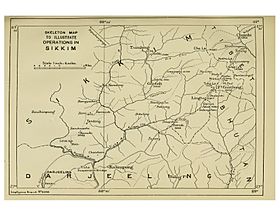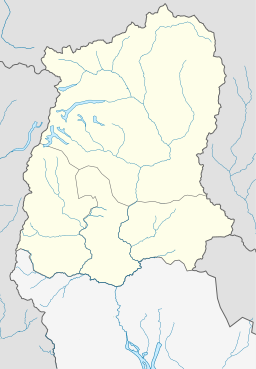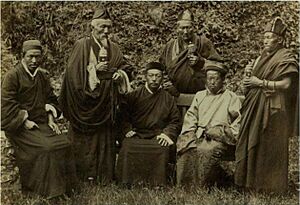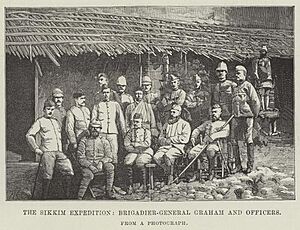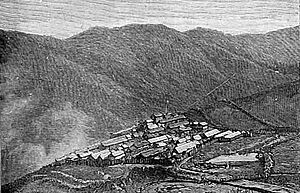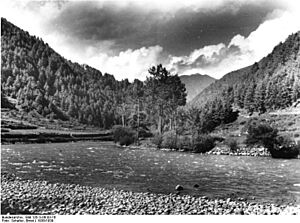Sikkim expedition facts for kids
| Lingtu | |
|---|---|
| Highest point | |
| Geography | |
| Parent range | Himalaya |
The Sikkim expedition (Chinese: 隆吐山戰役; pinyin: Lóng tǔshān zhànyì; literally "Battle of the Lingtu Mountain") was a military operation in 1888. British forces from India aimed to remove Tibetan troops from Sikkim. Sikkim is a small region in what is now northeast India. The main reason for this conflict was a disagreement. Both Britain and Tibet wanted to have control over Sikkim.
Contents
Why Did the Conflict Start?
Sikkim had a long history of connections with Tibet. Buddhism was the main religion in Sikkim. Its rulers, called Chogyals, had Tibetan roots. In the early 1800s, the British started to expand their power. They reached the Himalaya mountains. Sikkim signed a treaty with the British in 1861.
As Britain grew closer to Nepal, Sikkim, and Bhutan, Tibet's influence lessened. Leaders in Lhasa (Tibet) and Peking (China) worried. They feared Britain would enter Tibet through Sikkim.
Thutob Namgyal was the 9th Chogyal of Sikkim. He looked to the Dalai Lama for spiritual guidance. During his rule, Tibet's government began to regain political power in Sikkim. The 1861 treaty said the Chogyal could only spend three months in Tibet. But he often ignored this rule. In 1887, he had been in Tibet for almost two years. He refused to meet a British official in Darjeeling. He said the Amban (a Chinese official in Lhasa) told him not to go. He also sent money collected in Sikkim to Chumbi. This showed he did not plan to return to Sikkim.
In 1884, the Indian government planned to send a group to Lhasa. They wanted to define the borders between Tibet and India. But this plan was put on hold. Tibet sent 300 soldiers. They crossed the Jelep La pass. They then occupied Lingtu, about 13 miles inside Sikkim.
The British decided to delay their mission. They thought its presence was why Tibet occupied the area. However, the Tibetans did not leave. They built a strong gate on the road at Lingtu. They also built a fort to defend it. Talks with the Chinese government failed. So, the Indian government ordered a military group to Lingtu. Their goal was to take back control of the road.
Sending the Expedition
In 1888, while talks continued, Britain prepared for war. In January, they sent soldiers to the border. These troops repaired a bridge and a road. They also set up resting places for the expedition. Tibet received a warning to withdraw its troops by March 15.
On February 25, Brigadier-General Thomas Graham was ordered to march. His forces included soldiers from the Derbyshire Regiment and the Bengal Infantry. He also had four artillery guns and Sikh Pioneers. His orders were to remove Tibetans from Lingtu. He was to take back British control of the road to Jelep La. He also had to secure Gantok and Tumlong from attacks. He was not told to enter Tibet. That decision was left to him.
A supply base was set up at Dolepchen. All forces gathered at Padong by March 14. They were split into two groups. Graham led the Lingtu group. Lieutenant-Colonel Mitchell led the Intchi group.
Jeluk and Lingtu Battles
Mitchell sent 200 men to Pakyong. He stayed in Padong. Graham moved to Sedongchen on March 19. This was about 7 miles from Lingtu. The next day, he attacked the Tibetan fort at Jeluk. The Tibetans had blocked the road. They built a fort on a hill overlooking the road.
Graham advanced along the road. Pioneers cleared the path of bamboo and plants. A hundred Derbyshire men and two artillery guns followed. The difficult land made progress slow. But once they reached the fort, the Tibetans quickly retreated. The Tibetan bows and old guns were no match for British rifles and artillery. After taking the fort, the British pushed the defenders from a stone wall. They stopped chasing the retreating Tibetans.
After the Jeluk battle, Graham regrouped his men. He advanced to Garnei, about a mile from Lingtu fort. They camped there for the night. The next morning, the column moved slowly through mist and snow. Around 11 AM, the 32nd Pioneers took the fort's gate. It was guarded by only about 30 Tibetan soldiers.
Fighting at Gnathong
After leaving Lingtu, the Tibetans crossed the border. They gathered in the Chumbi valley. They were defeated but not destroyed. In fact, they received more soldiers. The British prepared their defenses in Gnathong. This was a flat area about three or four miles north of Lingtu.
On May 21, the Lieutenant-Governor of Bengal arrived at Gnathong. The Tibetans attacked British defenses the next day at 7 AM. They had about 3,000 men (according to British claims). The fighting lasted until 10 AM, when the Tibetans retreated. The British reported three killed and eight wounded. They claimed to have killed about a hundred Tibetans. The Tibetans went back across the Jelap La pass. No more fighting happened then. In June, the British began sending some troops back to Darjeeling.
Renewed Operations
In late July, as British troops left, Tibetans became active again. They were building forts in the mountain passes. These passes were above the Chumbi valley. Colonel Graham had only 500 men. He also had a small group at Gnathong. The Bengal government thought Tibetan forces were much larger. They estimated 7,000 soldiers near Rinchingong and Kophu. Plus, 1,000 more were at Lingamathang.
Quickly, Bengal sent more soldiers. By the end of August, Graham's forces at Gnathong grew. He now had 1,691 soldiers and four guns.
After some small fights, Tibetans crossed the Tuko La pass. This was about two miles from Gnathong. They quickly started building a wall on the pass's ridge. It was about three or four feet high and almost four miles wide. Colonel Graham attacked the Tibetan positions around 8 AM. He used three groups of soldiers. He led the left group, which attacked a small fort. This fort guarded the Tuko La pass. Lieutenant-Colonel Bromhead led the center group. They advanced up the main road to Tuko La. The right group, led by Major Craigie-Halkett, was to take a hill. They would hold the Tibetans' left side.
Around 9:30 AM, the attack began. British artillery fired on the Tibetan left side. By 10:30 AM, the other two British groups met the Tibetans. The British broke through the defenses. They captured the Tuko La pass. After this, the Tibetans retreated through the Nim La pass. After securing his sides, Colonel Graham attacked the Tibetans at Jelep La pass. This pass was attacked at 2:00 PM and captured soon after. The next day, the chase continued. By 4:00 PM, the British had occupied Rinchingong.
Chumbi Valley and Gangtok
The next day, September 26, the British moved forward. They went 3 miles along the Ammo Chu river. They camped for the night at Myatong (Yatung). The Tibetans were disorganized. They did not stop the British advance.
Meanwhile, Graham felt he needed to go to Gangtok. This was the capital of Sikkim. There, a group that supported Tibet had removed the group that supported India. Colonel Mitchell, with 150 men, marched to the city on September 23.
The Calcutta Agreement
After moving into Chumbi and Gangtok, the fighting stopped. On December 21, the Chinese official in Lhasa arrived at Gnathong. Talks began, but no agreement was reached. So, the Amban returned to Rinchingong. He was told to wait for Mr. T. H. Hart. Mr. Hart was from the Chinese Imperial Customs Service. He finally arrived at Gnathong on March 22, 1889.
Finally, the Anglo-Chinese Convention of Calcutta was signed. This happened on March 17, 1890, in Kolkata. This agreement stated that Tibet gave up its control over Sikkim. It also set the border between Tibet and Sikkim.
See Also


